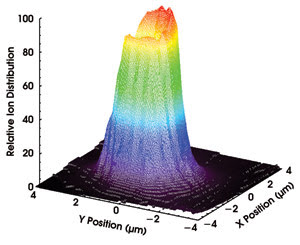Kent Rochford, National Institute of Standards and Technology
In the even-numbered years since 1980, optoelectronics metrologists have met in Boulder, Colo., for the Symposium on Optical Fiber Measurements (SOFM). Representing industry, academe and government, the participants report on measurement advances and promote the use of the best practices and standardized measurements.
SOFM 2004 took place Sept. 28 to 30 and was hosted by the National Institute of Standards and Technology’s (NIST) Optoelectronics Div. in Boulder, in cooperation with the Optical Society of America and IEEE Lasers and Electro-Optics Society. It drew scientists from 15 countries, and more than half of the papers originated from outside the US. A review of key papers presented provides insight into the status of fiber measurements and a good indication of future developments of the technology.
In fiber metrology, Fotios Sidiroglou from the University of Melbourne, Victoria, in Australia described a microanalytical technique for imaging erbium fiber cross sections to obtain the erbium-ion distribution. Typically, this distribution is measured in the preform before drawing. Extrapolating preform measurements to the fiber, however, cannot account for the dopant diffusion during the fiber draw that may cause erbium redistribution.
This new technique, employing a Raman confocal imaging system, provides a direct measurement of ion distribution with submicron resolution. Argon-ion laser pump light, focused on the fiber end face with a microscope objective, excites a fluorescence transition that is collected by the objective (see figure). The integrated fluorescence is a measure of the local erbium concentration.

A two-dimensional fluorescence profile was detected at the end face of a cleaved erbium-doped fiber.
To verify the results, Sidiroglou and colleagues from Victoria University in Melbourne and the University of Western Australia in Crawley also compared the erbium distribution measurement with quantitative phase microscopy. Better measurements of erbium profile could lead to a better understanding of fiber lasers and amplifiers.
A collaboration between Mark Wegmuller and colleagues at the University of Geneva in Switzerland and Kim P. Hansen and colleagues at Crystal Fibre A/S of Birkerød, Denmark, presented measurements of the polarization properties of index-guiding photonic crystal fibers and an air-guided photonic bandgap fiber. Both types of fibers often exhibit unintentional polarization effects because the fiber birefringence is exceedingly sensitive to structural symmetry. No intentional asymmetries were designed into the fibers studied, which were fabricated with state-of-the-art techniques. However, the reported birefringence was significant and only two to three times smaller than that for standard polarization-maintaining Panda fiber.
The researchers also observed that the principal states of polarization in the photonic bandgap fiber exhibited strong wavelength variation, suggesting the presence of polarization mode coupling. The measurements suggest that improvements in axial symmetry still are needed to obtain low-birefringence fibers.
Michael G. Taylor of University College London reported a phase-diverse, sampled coherent detection analyzer that enables the measurement and display of the electric field phase diagram (a view of the in-phase component plotted against the quadrature component) of a modulated signal. Such measurements provide information that is not apparent in an eye diagram and that could result in better identification of impairments to received signals (for example, cross-phase modulation, four-wave mixing and chromatic dispersion) based on the unique signatures in phase diagrams.
Christophe Dorrer of Bell Labs-Lucent Technologies in Holmdel, N.J., presented “Concepts and techniques for short optical pulse characterization,” which described spectrographic, interferometric and tomographic methods of pulse characterizations. These have applications to the measurement of chirp and spectral phase, the optimization of pulse compression and the reconstruction of pulse electric fields.
Leo W. Hollberg of NIST in Boulder reviewed the recent dramatic advances in optical frequency references. Optical frequency references now display the lowest observed phase noise, exhibit femtosecond levels of jitter and provide unprecedented stability. A combination of stabilized optical frequency combs, highly stabilized CW lasers, and precision spectroscopy of laser-cooled atoms and ions has led to an improvement by a factor of 1000 in the performance of frequency references over the past four years. These capabilities will initiate improvements in optical frequency synthesis, metrology and coherent control, and could enable femtosecond-precision timing and synchronization, and microwave sources with ultralow phase noise.
Representatives from the networking and test-and-measurement industries spoke at the SOFM 2004 workshop “Fiber to the Masses: Metrology and Motivation for the Last Mile.” Scott Wilsey of World Wide Packets in Spokane Valley, Wash., and David Cleary of Optical Solutions Inc. in Minneapolis described active and passive optical network solutions for bringing broadband to the home, respectively.
Both agreed that fiber to the home could be deployed profitably for so-called “triple play” offerings — voice, data and video — in new housing developments as well as in currently served areas. Active approaches can run over longer distances with higher bandwidths. Passive optical network systems, which have no active elements between the optical line terminal and the customer, broadcast in a point-to-multipoint architecture downstream, but they use time-division multiple-access transmission upstream.
Marc Breton of Exfo in Vanier, Quebec, Canada, discussed the unique metrology issues associated with these last-mile networks. The testing of passive optical networks during installation requires inexpensive, optical loss test sets with the ability to discriminate among multiple wavelengths. Testing for service activation faces the practical challenge of multiple wavelengths (1490 and 1550 nm) on the downstream signal and measuring upstream 1310-nm signals that are dark unless polled. Unique optical time-domain reflectometer characteristics for passive optical networking applications include high dynamic range, short dead zones, three-wavelength testing (1310, 1490 and 1550 nm), linearity and a lack of long-term recovery.
The SOFM 2004 Technical Digest is available for download from the NIST Optoelectronics Div. Web site at http://www.boulder.nist.gov/div815/sofm. Earlier editions also are available.
Meet the author
Kent Rochford is director of the Optoelectronics Div. at NIST in Boulder, Colo.; e-mail: [email protected].